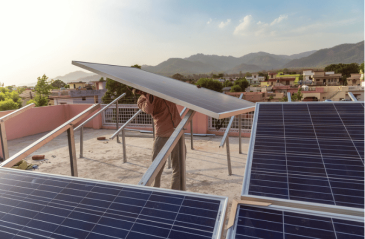
The power of storytelling in climate leadership

The goods and services that flow across the oceans are worth $2.5 trillion each year
Share articleClimate change, storm damage and overexploitation of fish stocks are all impacting oceans
Share articleBusinesses, consumers and governments need to come together to safeguard the world's oceans
Share articleWe put our vision for government into practice through learning partner projects that align with our values and help reimagine government so that it works for everyone.
Look, I'm not complaining. I live and work in Paris - truly one of the coolest cities in the world - but I must admit to occasionally pining for previous homes and experiences, especially those by the sea.
I've had the good fortune to live in South Africa for a period, as well as Southeast Asia, where I spent quite a bit of time in Raja Ampat in Papua New Guinea (PNG). Both are blessed with amazing biodiversity, which I got to see up close while scuba diving, and both feature highly in our new report, The Economic Imperative to Revive Our Oceans.
Although the memory of the crystal-clear waters will always stay with me, any recollection is mirrored by my concern at the fragility of life beneath the ocean waves. Especially because - as our report attests - such habitats are rapidly changing and degrading. I know that when I return in five or ten years' time, they won't be the same.
A couple of years ago, The Boston Consulting Group, together with the World Wide Fund for Nature (WWF) and the Global Change Institute at the University of Queensland, Australia, published Reviving the Ocean Economy: The Case for Action—2015, which examined the economic rationale for safeguarding the oceans. The report followed some earlier BCG research on the Baltic Sea, which indicated that the ocean's health varies widely and that sustainability must be tailored to local circumstances.
As a follow-up to both reports, we teamed up again with WWF and the Global Change Institute to analyse three different ocean environments: Melanesia, which is made up of a cluster of islands - Fiji, New Caledonia, PNG, the Solomon Islands, and Vanuatu; the Western Indian Ocean, made up of coastal Eastern Africa and islands from the Seychelles to Madagascar; and the Mediterranean. This work is important for any number of reasons. For some of us, the sea is a place for swimming, sailing, and living near. But for countless others - hundreds of millions, in fact - it represents their livelihood.
Did you know, for example, that the range of goods and services that flow from the world's coastal and marine environments can be valued conservatively at US$2.5 trillion each year, making the ocean the world's seventh largest economy? Its global assets can be valued at more than US$24 trillion, creating jobs and supporting industries such as fishing, tourism and shipping.
Unfortunately, our economic dependence on the ocean has not made it immune to the prevalent dangers of everyday life - both man-made and natural. Climate change, the increasing damage wrought by storms, and the overexploitation of fish stocks are just a few of the issues making waves - there are plenty more. Perhaps because so much of the threat exists below the surface of the sea, out of sight for most of us, the protection of oceans has received limited attention to date, but this, thankfully, is starting to change.
In all three cases - Melanesia, the Western Indian Ocean and the Mediterranean - the seas have an enormous economic importance, but they enjoy different levels of health. Melanesia and the Western Indian Ocean are still in relatively good shape, although their risks are increasing, while the Mediterranean (like the Baltic) is already seriously degraded. Because the threats in each region differ substantially, the strategies for economic revival and sustainability should differ as well. That said, we have identified four building blocks that should be implemented in every region.
A large part of the marine economy depends on the extraction of resources, such as fish and shellfish. However, too often we take more than can be naturally replenished. It is critical, then, to balance the need for extraction with an eye towards long-term productivity. So in Melanesia, for example, this means avoiding any further increase in fishing on coastal and offshore fish stocks. Tempting though fish stocks may seem today, we must always look to sustaining future supplies in order to avoid killing the goose that laid the golden eggs.
We also need to preserve key habitats. In the oceans, just as on land, certain places are especially important to the health of the broader ecosystem. Well-protected and interconnected habitats in specific regions not only sustain themselves but are catalysts for renewal and recovery throughout the entire ocean.
It can be done. There are promising examples of protected marine areas and coastal ecosystems that do thrive. But there are also areas protected in name only, which therefore fail to deliver on their potential. Through UN agreements, most governments have committed to increasing protected ocean areas to 10% by 2020, but more is needed to be done to achieve this goal, and many scientists believe that more of the ocean will ultimately require protection.
It almost goes without saying, but we must tackle climate change and build climate resilience. Increasing levels of CO2 in the atmosphere are creating acidification of the sea, which threatens corals, shellfish, fish and microorganisms. If left unchecked, the combined effects of climate change could destroy most coral reefs by 2050. Higher water temperatures, rising tides and more intense storms due to climate change put further pressure on the ocean, including highly productive systems like mangrove swamps - which are also effective natural coastal barriers against storms. Local action to protect and restore these assets should be part of any climate change agenda.
And finally, we need to come together. While I know there is a risk of sounding trite, coalitions of businesses, communities, consumers and governments are the only way to achieve what is a true public good, one that requires a genuine concentration of stakeholders at the decision-making table.
Let's conclude with some numbers. You're never far from the sea - even in a landlocked city like Paris. The oceans cover 71% of the Earth's surface, as well as 99% of the living space on the planet. And that's not even considering the trillions of dollars in goods and services that flow from the world's coastal and marine environments each year.
These figures underline the scale of the challenge. But so, too, does the majesty of the sea - whether seen from land, or from above or below the waves. Few resources are as precious or as vital. It is incumbent on all of us to step up and halt destructive practices and make a global commitment to sustainability. Doing so will help us today, as well as preserve the ocean's health, and wealth, for the generations of tomorrow.












